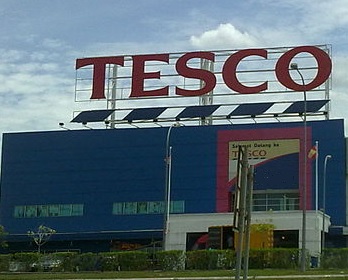The wearable technology now has a new shopping app that is to be “the beginning of the journey” for the chain.
Tesco, the British supermarket chain, has now launched a brand new mobile commerce app, but it isn’t the typical shopping or informational app for smartphone users, as it has been designed for Google Glass.
The goal of this m-commerce application is to make it faster and easier for consumers to shop online.
Google Glass users can download the Tesco mobile commerce app for free. It is voice controlled so that the user needs only speak the commands in order to search through the database of products at the supermarket. An example of the phrases that can be used is “OK Glass, find a product: milk”. Equally, users of the wearable technology can scan the item barcodes when they are in store or if they are in their own pantry and wish to re-purchase what they already have.
The mobile commerce app also allows the user to browse for items that they can add to their basket, as well.
 That said, when they want to actually check out, they will need to use the regular smartphone based m-commerce app. The intentions to create the Google Glass based application was first announced in June 2014. At that time, it was still a prototype.
That said, when they want to actually check out, they will need to use the regular smartphone based m-commerce app. The intentions to create the Google Glass based application was first announced in June 2014. At that time, it was still a prototype.
According to Pablo Coberly at Tesco, at the time of that first announcement, “We thought about how our colleagues might be able to use Glass to check stock hands-free, or how our customers might be able to add a product to their grocery delivery basket while making a cup of tea.” He also added that arriving at that phase along the way has brought about new concepts with regards to user interactions, including “user interface elements, new gestures, and input mechanisms.”
Clearly, Tesco came a long way since that time, as they have now launched the Google Glass mobile commerce experience. Coberly recently blogged on the subject, singing the praises of the SDK for the wearables, and applauding the Glass team at Google for the support and experience that they provide.
At the same time that consumers are being warned about their privacy over smartphones, those devices could also help.
A mobile technology trend involving the use of smartphones and tablets to help to improve local security among residents of a neighborhood and in tracking, through the combination of smartphones and social media apps.
These tools are becoming an increasing part of various types of community policing program.
The key is that smartphones are owned by the majority of adults, and among the owners of that mobile technology, most use social media apps. Moreover, they spend a great deal of time on those applications and they access them on a regular basis. This, as a result, is providing a useful tool in the help to fight crime. A new trend has started with private security companies as well as with the Community Policing Forum (CPF), where this tech and these mobile apps are combined in order to be able to raise awareness of issues and to alert residents when a problem may be present.
A growing number of specific instances of the use of mobile technology for crime fighting and safety has been occurring.
 One example, among many, occurred on New Year’s Day, in Glenvista, South Africa. Just before opening at 8am, the Glenvista Shopping Centre Checkers store was robbed. This involved a situation in which an estimated seven suspects had stolen an undisclosed amount of money from the cash office. In this case, the robbery was discussed on the CPF Facebook page, where there were a number of important leads and connections made that brought about several advancements toward solving this crime. The good relationship between the CPF and the police has continued since then and they work closely.
One example, among many, occurred on New Year’s Day, in Glenvista, South Africa. Just before opening at 8am, the Glenvista Shopping Centre Checkers store was robbed. This involved a situation in which an estimated seven suspects had stolen an undisclosed amount of money from the cash office. In this case, the robbery was discussed on the CPF Facebook page, where there were a number of important leads and connections made that brought about several advancements toward solving this crime. The good relationship between the CPF and the police has continued since then and they work closely.
Other CPFs within the community are also using mobile apps to be able to help in battling crime. Community Watch is one of the apps that is being used the most widely, as it brings together an instant messaging service with a direct connection to CPFs, private security companies, and even the police.
These are only a couple of examples of the important role that mobile technology is starting to play in the safety of individuals and entirely communities in South Africa, as regular everyday people and law enforcement officials work together to improve their own security using smartphones and apps.
 That said, when they want to actually check out, they will need to use the regular smartphone based m-commerce app. The intentions to create the Google Glass based application was first announced in June 2014. At that time, it was still a prototype.
That said, when they want to actually check out, they will need to use the regular smartphone based m-commerce app. The intentions to create the Google Glass based application was first announced in June 2014. At that time, it was still a prototype.
 One example, among many, occurred on New Year’s Day, in Glenvista, South Africa. Just before opening at 8am, the Glenvista Shopping Centre Checkers store was robbed. This involved a situation in which an estimated seven suspects had stolen an undisclosed amount of money from the cash office. In this case, the robbery was discussed on the CPF Facebook page, where there were a number of important leads and connections made that brought about several advancements toward solving this crime. The good relationship between the CPF and the police has continued since then and they work closely.
One example, among many, occurred on New Year’s Day, in Glenvista, South Africa. Just before opening at 8am, the Glenvista Shopping Centre Checkers store was robbed. This involved a situation in which an estimated seven suspects had stolen an undisclosed amount of money from the cash office. In this case, the robbery was discussed on the CPF Facebook page, where there were a number of important leads and connections made that brought about several advancements toward solving this crime. The good relationship between the CPF and the police has continued since then and they work closely.